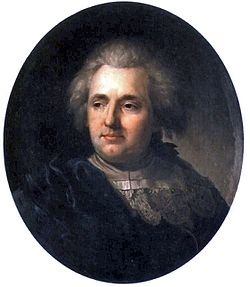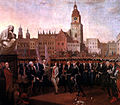refs |
124.190.113.128 (talk) No edit summary |
||
| Line 1: | Line 1: | ||
[[Image:PeszkaJozef.PortretFranciszkaSmuglewicza.jpg|thumb|250px|right|Franciszek Smuglewicz by [[Józef Peszka]], his student.]] |
[[Image:PeszkaJozef.PortretFranciszkaSmuglewicza.jpg|thumb|250px|right|Franciszek Smuglewicz by [[Józef Peszka]], his student.]] |
||
'''Franciszek Smuglewicz''' |
'''Franciszek Smuglewicz''' ({{lang-lt|Pranciškus Smuglevičius}}<ref name=LITH>{{cite book | last = McLachlan | first = Gordon | authorlink = | coauthors = | title = Lithuania | publisher = Bradt Travel Guides | date = 2008 | location = | pages = 40 | url = | doi = | id = | isbn = 1841622281 }}</ref><ref name=BALTIC>{{cite book | last = Rosenfeld | first = Alla | authorlink = | coauthors = Norton T. Dodge | title = Art of the Baltics | publisher = Rutgers University Press | date = 2001 | location = | pages = 290 | url = | doi = | id = | isbn = 0813530423 }}</ref>, [[October 6]] [[1745]] – [[September 18]] [[1807]]) was a [[Polish people|Polish]]-[[Lithuania]]n draughtsman and [[painting|painter]]. Smuglevičius is considered as founder of modern [[Culture of Lithuania|Lithuanian art]].<ref name=LITH/> Some scholars considers him as a spiritual father of [[Jan Matejko]]'s school of painting.{{fact|date=April 2009}}. He was a brother of [[Antoni Smuglewicz|Antoni]]. |
||
==Biography== |
==Biography== |
||
Revision as of 00:56, 21 April 2009

Franciszek Smuglewicz (Lithuanian: Pranciškus Smuglevičius[1][2], October 6 1745 – September 18 1807) was a Polish-Lithuanian draughtsman and painter. Smuglevičius is considered as founder of modern Lithuanian art.[1] Some scholars considers him as a spiritual father of Jan Matejko's school of painting.[citation needed]. He was a brother of Antoni.
Biography
Smuglewicz was born in Warsaw of mixed Polish-Lithuanian family.[1] His father, Łukasz Smuglewicz, also a painter, had moved there from the province of Samogitia. In 1763 Franciszek journeyed to Rome, where he began the study of fine arts under the tutorship of Anton von Maron. He stayed in Rome for next 21 years, where he became follower of Neo-Classical style.
In 1765 he received a royal scholarship from king Stanisław August Poniatowski and was admitted into Saint Lucas Academy. As a collaborator of Vincenzo Brenna he participated in the inventarisation of Nero`s Domus Aurea. In 1784 he returned to Warsaw, where he founded his own school of fine arts, one of the predecessors of the modern Academy of Fine Arts.
A classicist, but under strong influence of the Polish baroque[citation needed], Smuglewicz became the notable representative of historical painting, a notion that dominated the fine arts of Poland throughout the 19th century. Around 1790 he started working on a series of sketches and lithographies inspired by Adam Naruszewicz's History of the Polish Nation. Although never finished, the series gained him much popularity.
In 1797 he moved to Vilnius, where he became the founder and the first deacon of the Institute of Sketch and Painting at the Academy of Vilnius. A tutor of several generations of Polish-Lithuanian painters, Smuglewicz devoted himself to historical painting in the latter years of his life. He brought to Lithuania classical ideas and views of enlighten classicism. He realistically painted every day life, architecture of Vilnius. His works have profound importance for the ongoing reconstruction of the Royal Palace of Lithuania, as being the one of the reliable source to meticulously present their authentic features. During decade spend in Vilnius he produced notable paintings like Lithuanian Peasants, Freeing Peasants from Serfdom in Merkinė.[2]
Among the notable surviving works of that period are A Meeting of the Four Years' Sejm (1793) and Kościuszko's Oath at Kraków's Old Town Market (1797). He also painted a series of depictions of contemporary views of Vilnius. Among his works of the period are priceless views of the city walls and city gates, demolished in 19th century.
He was buried at the Rasos Cemetery, although his grave location has been lost.
References
- ^ a b c McLachlan, Gordon (2008). Lithuania. Bradt Travel Guides. p. 40. ISBN 1841622281.
{{cite book}}: Cite has empty unknown parameter:|coauthors=(help) - ^ a b Rosenfeld, Alla (2001). Art of the Baltics. Rutgers University Press. p. 290. ISBN 0813530423.
{{cite book}}: Unknown parameter|coauthors=ignored (|author=suggested) (help)
-
Scythians meeting with Darius, 1785
-
Portrait of the Prozor Family, 1789, National Museum in Warsaw
-
"Tadeusz Kościuszko taking the oath", 1797


